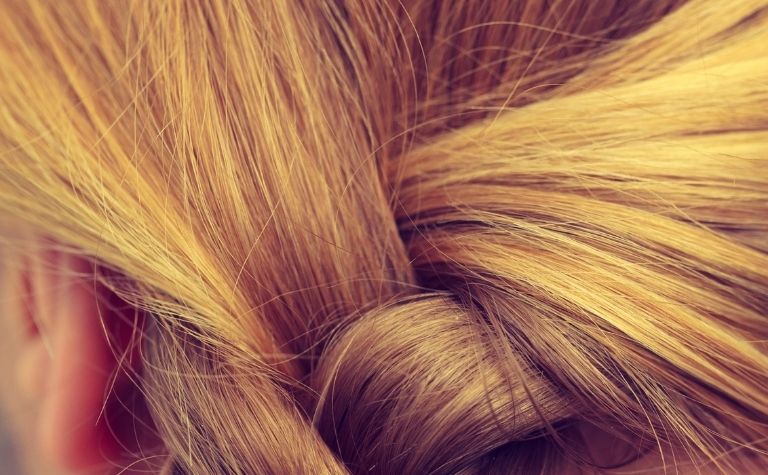Recent depictions of Viking women often portray them with elaborately braided hair, mohawks, dreadlocks, and partially shaved heads.
However, Medieval female Vikings had limited hairstyles.
Five of the traditional female Viking hairstyles include:
- The Irish ribbon knot
- The Arden braid
- The Elling braid
- The Kransen for maidens
- Buns and caps for married women
According to archaeological evidence, Viking women often wore their hair in protective styles, although younger females wore their hair more loosely than married women as a symbol of their virginity.
Married women tucked their hair in caps or buns to indicate their status.
Also see What Color Eyes Did Vikings Have? to learn more.

1. The Irish Ribbon Knot
The Irish ribbon knot is the most frequently depicted female hairstyle in Viking Age art and artifacts. [1]
However, modern historians and archaeologists identify most of the female figures depicted wearing this hairstyle as mythical beings and valkyries, so it’s unclear whether this hairstyle was a common one among typical Viking women.
However, the simplicity of the Irish ribbon knot would make it an easy-to-achieve style that took little effort and no cord, sticks, or needles to complete.
Because of its ease, it may have been very common, but there’s no strong evidence for it other than stylized depictions and reliefs. [2]
To achieve the Irish ribbon knot, the woman would have followed these steps:
- She gathered her hair in her hand to form a low ponytail.
- Then she wrapped the hair around the back of the hand to secure her ponytail, creating a loose loop.
- Next, she placed her free hand through the loop and pulled the ends of the ponytail through the hair loop, forming a knot.
- She then pulled the knot tightly against her head to secure her hair.
The woman may have pinned the knot in place or worn a protective head covering to keep the knot secure.
Also see Why Are Scandinavian Women So Beautiful? to learn more.
2. The Arden Braid
Evidence for this hairstyle starts with the Arden Woman, a “bog corpse” found in Denmark. [3]
She seems to have died sometime around the second century B.C., well before the Viking Age, but her hairstyle was likely a traditional one that many Viking women wore in the centuries to come.
The Arden Woman was buried in a bog, and the conditions there preserved most of her body, including her clothing, dark blonde hair, and stomach contents.
Her body and clothing are now on display at the National Museum of Denmark. [4]
Her hairstyle featured a crown of two braids woven to encircle her head.
The style begins with two low-set braids, one on each side of the head.
These braids are then secured using a long length of suede or wool cord.
To secure the cord, the wearer would have folded one cord over on itself once, then created a slipknot around the base of the braid.
She would have then wrapped each side of the cord in alternating directions around the braided hair and fastened the ends using a knot at the end.
Then, the braids are laid over the head in opposite directions, with the ends falling to the nape of the neck.
These braids were likely then pinned in place using a stick or comb while the woman secured the braids with more cord.
She would have used a bone-darning needle and an extra piece of cord to whip stitch the braids to her head, working from the base of one braid to the other, forming a crown.
Then, the remaining length of the working cord was either tied off at the back of the head or tucked into a braid to secure it.
Then, any loose ends were woven into the hair using either fingers or the darning needle.
Due to the time and effort it takes to achieve such a hairstyle, the Arden braid was likely a more formal way of wearing the hair, or it was a protective style that the woman would wear for several days.
Also see Why Do Scandinavians Have Asian Eyes? to learn more.

3. The Elling Braid
The Elling braid is a hairstyle worn by the Elling Woman, a body discovered in Denmark. [5]
She is believed to have died between 350 and 150 B.C.
Her well-preserved remains indicate that she was hanged in her mid-20s. Her hair was exceedingly long, with the entire length measuring just over 35 inches (90 cm).
The Elling Woman’s hairstyle was a simple one-braid protective style.
To create this hairstyle, the Elling woman likely followed these steps:
- She gathered the top section of hair around the crown of her head and braided it until she reached the area around her back hairline.
- Then, she braided in the rest of her hair, forming one long braid.
- She then wrapped the end of this longer braid into the first braided section of hair directly on the back of her head.
- She may have wrapped this hair two or three times with the tail end of the braid hanging loosely. [6]
However, historians are unsure whether the Elling woman completely wrapped the braid into this top section to form a bun.
Since the Elling woman died a rather violent death, her hair may have come loose as she was hanged and buried. So, the style either features a long, trailing braid or a braided bun.
4. The Kransen for Maidens
Unmarried Viking women often wore their hair loose or in untucked braids to symbolize their maidenhood.
These unmarried Viking women traditionally wore a Kransen, similar to a hairband, passed down from mother to daughter. [7]
Young Viking women wore this band to secure their loose hair and keep it away from the face.
However, even unmarried Viking women likely wore the Irish ribbon knot, Arden braid, or Elling braid with their Kransen.
Such occasions where young women wore their hair up probably included religious observances and special events.
The primary difference between these virgins and married women was that the maidens kept these styles uncovered by a cap.
On a female Viking’s wedding day, female family members and friends would ritually remove the Kransen, making her new status as a married woman.
Also see What Are Norse Tattoos To Avoid? to learn more.

5. Buns and Caps for Married Women
Many female Viking hairstyles are untraceable through art since most married Viking women kept their hair covered or tightly wound in a bun. [8]
However, later literary evidence suggests that many groups required married women to keep their hair covered with caps during the latter half of the Viking age.
These protective coverings would have made married and unmarried Viking women easily identifiable. In addition, it would have protected the wearer’s hair and kept her warm in the colder months.
The most popular of these caps was called the Jorvik (York) cap, a curved head covering that resembles a modern-day hood with a tie that would have secured it under the chin of the wearer.
These caps were square-shaped with a rounded corner to hug the crown of the head. In three archaeological examples, these hoods were made of undyed silk and likely had linen ties.
However, silk was a luxury and imported item, so most Viking women likely had hoods of linen or wool.
Another prevalent example is the Dublin cap, a more narrow, rectangular hood with a point at the crown of the head.
Viking women may have worn braids, buns, the Irish ribbon knot, or other styles underneath these hoods to secure and cover their hair.
Other married women secured their hair in a bun using a hair stick.
Conclusion
Female Vikings wore protective hairstyles such as ponytails and braids. Maidens wore the Kransen with these styles, while married women wore buns or caps.
Also see Did the Vikings Share Their Wives? to learn more.
References:
[1] Source
[2] Source
[3] Source
[4] Source
[5] Source
[6] Source
[7] Source
[8] Source
